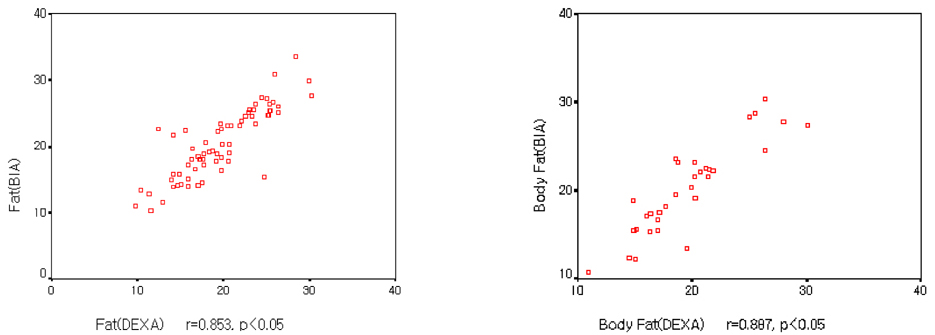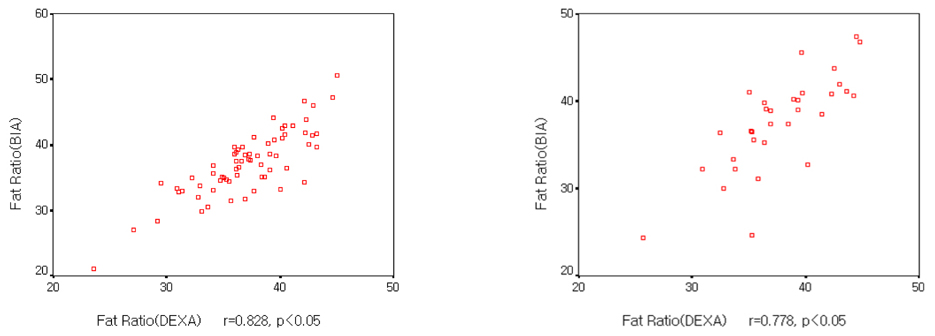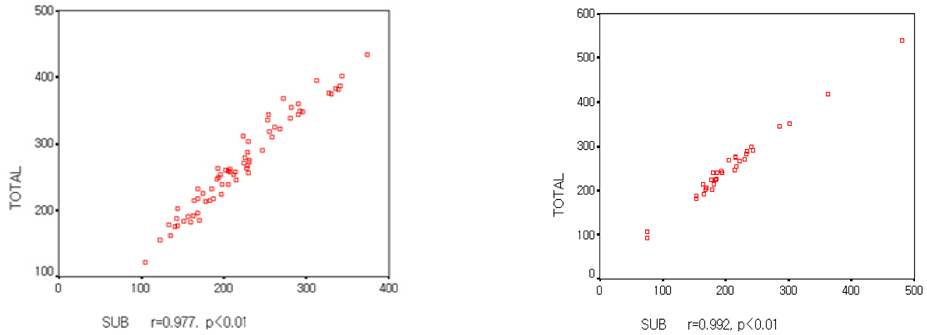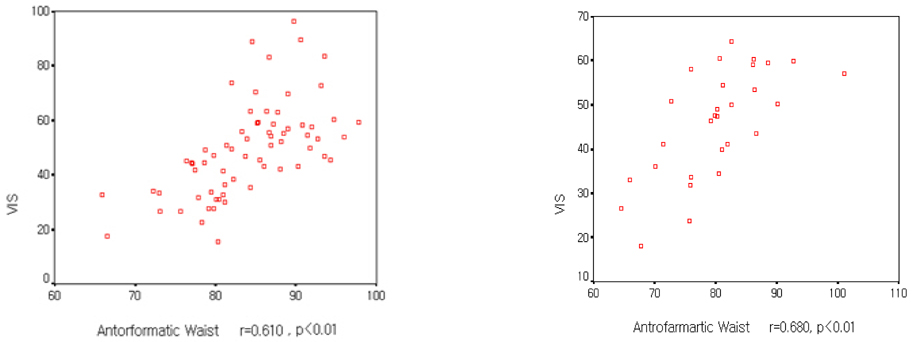Nutr Res Pract.
2010 Apr;4(2):128-135.
Comparisons of obesity assessments in over-weight elementary students using anthropometry, BIA, CT and DEXA
- Affiliations
-
- 1Obesity Research Center, Chonbuk National University, Deokjin-dong, Deokjin-gu, Jeonju 561-756, Korea. cha8@chonbuk.ac.kr
- 2Department of Food Science and Human Nutrition, Chonbuk National University, Deokjin-dong, Deokjin-gu, Jeonju 561-756, Korea.
- 3Department of Internal Medicine, Chonbuk National University, Deokjin-dong, Deokjin-gu, Jeonju 561-756, Korea.
Abstract
- Obesity was characterized in Korean elementary students using different obesity assessment tests on 103 overweight elementary students from three schools of Jeonbuk Province. The body mass index (BMI) and obesity index (OI) were compared, and the data using DEXA and CT were compared with the data using BIA and a tape measure. The results of this study are as follows: first, 27 students who were classified as obese by OI were classified as overweight by BMI, and 3 students who were classified as standard weight by BMI were classified as overweight by OI. Secondly, by DEXA and BIA measurements, there was 1.51% difference in body fat percentage (boys 1.66%, girls 1.17%) and the difference in body fat mass between boys and girls was 0.77 kg (boys 0.85 kg, girls 0.59 kg), but those differences in body fat percentage and mass were not statistically significant. Thirdly, the average total abdominal fat (TAF) measured by CT scans of obese children was more significantly related with subcutaneous fat (r = 0.983, P < 0.01) than visceral fat (r = 0.640, P < 0.01). Also, TAF were highest significant with waist circumference by a tape measure (r = 0.744, P < 0.01). In summary, as there are some differences of assessment results between two obesity test methods (BMI, OI), we need more definite standards to determine the degree of obesity. The BIA seems to be the most simple and effective way to measure body fat mass, whereas waist/hip ratio (WHR) using a tape measurer is considered to be the most effective method for assessing abdominal fat in elementary students.
Keyword
MeSH Terms
Figure
Reference
-
1. Blackman MR. Principles of ambulatory medicine. 1994. 4th ed. Williams and Wilkins Co: Baltimore.2. Bae JM, Kim DS, Kim JY, Ahn YO. A distribution of waist-hip ratio associated with the blood pressure in middle-aged men. Korean J Prev Med. 1999. 32:395–399.3. Kurpad SS, Tandon H, Srinivasan K. Waist circumference correlates better with body mass index than waist-to-hip ratio in Asian Indians. Natl Med J India. 2003. 16:189–192.4. Key A, Fidanza F, Karvonen MJ, Kimura N, Taylor HL. Indices of relative weight and obesity. J Chronic Dis. 1993. 25:329–343.
Article5. Kim CG, Park SH, Kim KH, Kwon YW, Huh Y, Ma MR, Lee CH, Kim HH. Development of new regression equation for estimating body composition by underwater weight. Journal of Korea Sport Research. 2004. 17:329–340.6. Schon RE, Thaete FL, Sankey SS, Weissfeld J, Kuller LH. Sagittal diameter in comparison with single slice CT as a predictor total visceral adipose tissue volume. Int J Obes. 1998. 22:338–342.
Article7. Pullcino E, Coward WA, Stubbs RJ, Elia M. Bedside and field methods for assess-ing body composition: comparison with the deuterium dilution technique. Eur J Clin Nutr. 1990. 44:753–762.8. Mazess RB, Barden HS, Bidek JP, Hanson J. Dual energy x-ray absorptiometry for total-body and regional bone-mineral and soft-tissue composition. Am J Clin Nutr. 1990. 51:1106–1112.
Article9. Svendson OL, Haarbo J, Heitmann BL, Gotfredsen A, Chrstiansen C. Measurement of body fat in elderly subjects by dual-energy X-ray absorptiometry, bioelectrical impedance, and anthropometry. Am J Clin Nutr. 1993. 53:1117–1123.
Article10. Hammond J, Rona RJ, Chinn S. Estimation in community surveys of total fat of children using bioelectrical impedance or skinfold thickness measurement. Eur J Clin Nutr. 1994. 48:164–172.11. Schaefer F, Georgi M, Zieger A, Scharer K. Usefulness of bioelectrical impedance and skinfold measurements in predicting fat-free mass derived from total potassium in children. Pediatr Res. 1994. 35:617–624.
Article12. Kim HS. Assessment of body composition among 5 to 14 year old children-anthropometry, BIA and DXA. Korean J Phys Educ. 2006. 45:481–488.13. Kim IK, Kang JH, Song JH. Serum leptin levels and changes in body weight and obesity index in Gwacheon elementary school children. The Korean Journal of Nutrition. 2007. 40:736–744.14. Ko YH, Lee AR. Effects of aerobic exercise with nutrition education on body composition, physical fitness, and liver function of obese elementary school students. Journal of Korea Sport Research. 2006. 17:415–422.15. Oh SI, Jang JH, Hur S. Assessment of after-school obesity control program through on life habits and physical activity in obese elementary school children. Korean J Exerc Nutr. 2008. 12:1–6.16. Cho IS, Kim MW, Park IH, Ryu HS, Kang SY. Health promotion life profile of normal-weight and obese children in elementary schools. Journal of Korean Academy of Child Health Nursing. 2009. 15:61–70.
Article17. Jo MA, Lee KH, Her ES, Kim JA. A survey on dietary habits in Gyeongnam and the development of the nutrition education curriculum with teacher's guide for obese elementary school children. Journal of the Korean Dietetic Association. 2009. 15:97–112.18. Nam JH. Effects of a weight control program on anthropometric measurements and serum lipid profiles of obese elementary students. Korean J Food Nutr. 2007. 20:88–95.19. Leonard MB, Shults J, Wilson BA, Tershakovec AM, Zemel BS. Obesity during childhood and adolescence augments bone mass and bone dimension. Am J Clin Nutr. 2004. 80:514–523.
Article20. Ellis KJ. Human body composition: in vivo methods. Physiol Rev. 2000. 80:649–680.
Article21. Tyrrell VJ, Richards G, Hofman P, Gillies GF, Robinson E, Cutfield WS. Foot-to-foot bioelectrical impedance analysis: a valuable tool for the measurement of body composition in children. Int J Obes Relat Metab Disord. 2001. 25:273–278.
Article22. Poulit MC, Despres JP, Lemieux S, Moorjani S, Bouchard C, Termblay A. Waist circumference and abdominal sagittal diameter: best simple anthropometric index of abdominal visceral adipose tissue accumulation and related cardiovascular risk in men and women. Am J Cardiol. 1994. 73:460–468.23. Armellini F, Zamboni M, Percechuzzu G, Greco A, Napoli N, Pandolfo I, Mondello G, Bosello O. Computed tomography visceral adipose tissue volume measurements of Italians: predictive equations. Eur J Clin Nutr. 1996. 50:290–294.24. Ross R, Rissanen J, Hudson R. Sensitivity associated with the identification of visceral adipose tissue levels using waist circumference in men and women: effects of weight loss. Int J Obes. 1996. 20:533–538.25. Shin YH. A review of childhood obesity. Journal of Korean Academy of Child Health Nursing. 2005. 11:240–245.26. Seidell JC, Oosterlee A, Thijssen MA, Burema J, Deurenberg P, Hautvast JC, Ruijs JH. Assessment of intra-abdominal and subcutaneous abdominal fat : relation between anthropometry and computed tomography. Am J Clin Nutr. 1987. 45:7–13.
Article27. Wetis T, Beer EJ, Wedel M, Romeny BM. Computer tomography measurement of abdominal of fat deposition in relation to anthropometry. Int J Obes. 1998. 12:217–225.28. Kim HS. Abdominal obesity and health and exercise. J Korean Soc Living Environ Syst. 1999. 6:1–10.29. Kooy K, Leenen R, Seidell JC, Deutenberg P, Droop A, Bakker CJ. Waist-hip ratio is a poor predictor of change in visceral fat. Am J Clin Nutr. 1993. 57:327–333.
- Full Text Links
- Actions
-
Cited
- CITED
-
- Close
- Share
- Similar articles
-
- Comparison between Dual Energy X-ray Absorptiometry (DEXA) and Bioelectrical Impedence Analysis (BIA) in Measurement of Lean Body Mass and Fat Mass in Obese Adults: Based Bland-Altman Plot Analysis
- Comparison of Bioelectrical Impedance Analysis with Dual Energy X-ray Absorptiometry in Obese Women
- Relationship between the Body Fat Mass Measured by Bioelectrical Impedance Analysis (BIA) and Dual Energy X-ray Absorptiometry (DEXA), and by the Indices of Insulin Sensitivity
- Validity of Bioelectrical Impedance Analysis (BIA) in Measurement of Human Body Composition
- Association of Visceral Fat Area Measured by InBody 720 with the Results Measured by CT, DEXA and Anthropometric Measurement







